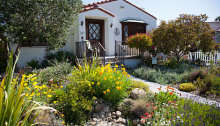
Fall through early spring is the best time to plant California’s native low-water-use plants.
Like all nursery stock, these plants need careful attention during their establishment period.
Ten Easy Steps:
(1) Dig a hole
twice as deep and twice as wide as the plant container. Break up large clods and try to avoid the smooth-sided “bathtub” effect in the hole
(2) Amendment
a) For many landscape and revegetation plantings, no soil amendment is recommended for California Friendly
plants. The native soil should be left soft and easy-to-crumble. Eliminate rocks and large clods from your backfill soil.
b) For landscapes requiring amendment, use approximately 1/3 composted or nitrolized forest humus to 2/3 native soil, blending them in a pile outside the hole.
c) Slow release fertilizer granules or tabs may be incorporated with the backfill, or placed in the bottom of the hole. If tabs are used make sure they are not touching the root ball. Most California Friendly plants are able to find nutrients even in poor soils. If a pre-plant fertilizer is used, application rates should be lower than those used for non-native ornamentals.
(3) Fill planting hole with water
and allow water to percolate (drain) into subsoil.
(4) Spill some backfill
material into the bottom of hole, moisten, tamp and mound slightly.
(5) Set plant root ball
atop the moistened backfill so that plant collar is one inch higher than finished grade.
(6) Replace backfill material
while adding water flowing slowly from a hose into the hole, backfilling up to about 2/3 the height of the root ball: moistening, tamping and settling all around.
(7) Fill remaining portion
surrounding the top of root ball with more backfill. Be sure collar is still higher than grade.
(8) Create an irrigation basin berm
considerably outside the dimension of the hole using remaining backfill and native soil.
(9) Mulch
Apply a generous portion (approximately 2 to 4 inches deep) of a coarse, organic, weed-free and disease-free mulch; topdressing around exposed collar and inside the entire basin area.
(10) Irrigate thoroughly
filling the basin with water and sprinkling around to settle backfill, mulch and berm. Allow to soak
in and repeat.
Additional smart watering tips:
It’s important that the root ball does not dry out during the first two or three months. Irrigate about once a week, trying not to oversoak the surrounding soil. After two months, be sure to water deeply, but do not allow the ground to remain soggy for long periods of time, as this encourages disease, especially during the dry season.
Info Source:
Irvine Water District
